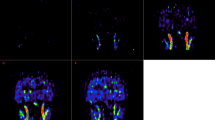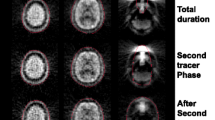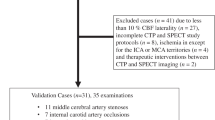Abstract
Cerebral blood flow (CBF) can be quantified non-invasively using the brain perfusion index (BPI), which is determined using radionuclide angiographic data obtained through the use of technetium-99m hexamethylpropylene amine oxime (99mTc-HMPAO). The BPI is generally calculated using graphical analysis (GA). In this study, BPI was measured using spectral analysis (SA), and the usefulness of SA was compared with that of GA. Thirteen patients with various brain diseases and four healthy male volunteers were examined using radionuclide angiography with99mTc-HMPAO. The BPI was measured for each subject using both SA and GA. In the four healthy volunteers, the BPI was examined at rest and after the intravenous administration of 1 g of acetazolamide (ACZ). An H2 15O PET examination was also performed in the 13 patients; the BPIS and BPIG values were compared with the CBF measurements obtained using H2 15O PET (CBFPET). The BPI values obtained by SA (BPIS) (x) and by GA (BPIG) (y) were correlated (y = 0.568x + 0.055, r = 0.901) in the 13 patients and four healthy volunteers at rest, although the BPIG values were underestimated by 36.1 ± 7.5% (mean ± SD) compared with the BPIS values. The degree of underestimation tended to increase with increasing BPIS values. The increase in the BPIS was 32.1 ± 8.0% after the intravenous administration of ACZ, while the increase in BPIG was only 8.1 ± 2.8%. This discrepancy was considered to be the result of the BPIG values being affected by the first-pass extraction fraction of the tracer. Although both BPIS and BPIG values were significantly correlated with the CBFPET values, the correlation coefficient for BPIS was higher than that for BPIG (BPIS: r = 0.881; BPIG: r = 0.832). These results suggest that SA produces a more reliable BPI for quantifying CBF using99mTc-HMPAO than the conventional method using GA. The SA method should be especially useful for activation studies involving pharmacological intervention and/or clinical cases with an increased CBF.
Similar content being viewed by others
References
Hellman RS, Tikofsky RS. An overview of the contributions of regional cerebral blood flow studies in cerebrovas-cular disease: is there a role for single photon emission computed tomography?Semin Nucl Med 1990; 20: 303–324.
Nakano S, Kinoshita K, Jinnouchi S, Hoshi H, Watanabe K. Critical cerebral blood flow thresholds studied by SPECT using xenon-133 and iodine-123 iodoamphetamine.J Nucl Med 1989; 30: 337–342.
Takasawa M, Watanabe M, Yamamoto S, Hoshi T, Sasaki T, Hashikawa K, et al. Prognostic value of subacute crossed cerebellar diaschisis: single-photon emission CT study in patients with middle cerebral artery territory infarct.AJNR Am J Neuroradiol 2002; 23: 189–193.
Matsuda H, Tsuji S, Shuke N, Sumiya H, Tonami N, Hisada K. A quantitative approach to technetium-99m hexamethyl-propylene amine oxime.Eur J Nucl Med 1992; 19: 195–200.
Matsuda H, Yagishita A, Tsuji S, Hisada K. A quantitative approach to technetium-99m ethyl cysteinate dimer: a comparison with technetium-99m hexamethylpropylene amine oxime.Eur J Nucl Med 1995; 22: 633–637.
Lassen NA, Anderson AR, Friberg L, Paulson OB. The retention of [99mTc]-L,D-HMPAO in the human brain after intracarotid bolus injection: a kinetic analysis.J Cereb Blood Flow Metab 1988; 8 (Suppl 1): S44-S51.
Cunningham VJ, Jones T. Spectral analysis of dynamic PET studies.J Cereb Blood Flow Metab 1993; 13: 15–23.
Murase K, Tanada S, Inoue T, Ikezoe J. Spectral analysis applied to dynamic single photon emission computed tomography studies with N-isopropyl-p-(123I)iodoamphetamine.Ann Nucl Med 1998; 12: 109–114.
Murase K, Inoue T, Fujioka H, Ishimaru Y, Akamune K, Yoshimoto Y, et al. An alternative approach to estimation of the brain perfusion index for measurement of cerebral blood flow using technetium-99m compounds.Eur J Nucl Med 1999; 26: 1333–1339.
Takasawa M, Murase K, Oku N, Yoshikawa T, Osaki Y, Imaizumi M, et al. Assessment of acetazolamide reactivity in cerebral blood flow using spectral analysis and technetium-99m hexamethylpropylene amine oxime.J Cereb Blood Flow Metab 2002; 22: 1004–1009.
Takasawa M, Murase K, Oku N, Kawamata M, Imaizumi M, Yoshikawa T, et al. Automatic determination of brain perfusion index for measurement of cerebral blood flow using spectral analysis and99mTc-HMPAO.Eur J Nucl Med 2002; 29: 1443–1446.
Haung SC. Quantitative measurement of local cerebral blood flow in humans by positron emission tomography and15O-water.J Cereb Blood Flow Metab 1983; 3: 141–153.
Llacer J, Veklerov E, Baxter LR, Grafton ST, Griffeth LK, Hawkins RA, et al. Results of a clinical receiver operating characteristic study comparing filtered backprojection and maximum likelihood estimator images in FDG PET studies.J Nucl Med 1993; 34: 1198–1203.
Inoue T, Fujioka H, Akamune A, Tanada S, Hamamoto K. A time-saving approach for quantifying regional cerebral blood flow and application to split-dose method with123I-IMP SPECT using a single-head rotating gamma-camera [in Japanese].KAKU IGAKU (Jpn J Nucl Med) 1995; 32: 1217–1226.
Murase K, Tanada S, Fujita H, Sakaki S, Hamamoto K. Kinetic behavior of technetium-99m-HMPAO in the human brain and quantification of cerebral blood flow using dynamic SPECT.J Nucl Med 1992; 33: 135–143.
Buell U, Schicha H. Nuclear medicine to image applied pathophysiology: evaluation of reserves by emission computerized tomography.Eur J Nucl Med 1990; 16: 129–135.
Marchai G, Young AR, Baron JC. Early postischemic hyperperfusion: pathophysiologic insights from positron emission tomography.J Cereb Blood Flow Metab 1999; 19: 467–482.
Takasawa M, Watanabe M, Yuasa Y, Iiji O, Hashikawa K, Matsumoto M, et al. Transient patchy boundary zone hyperemia following TIA episode with deep hemispheric ischemia: serial HMPAO SPECT study.J Neurol 2000; 247: 804–806.
Lassen NA, Spering B.99mTc-bicisate reliably images CBF in chronic brain diseases but fails to show reflow hyperemia in subacute stroke: report of a multicenter trial of 105 cases comparing133Xe and99mTc-bicisate (ECD, neurolite) measured by SPECT on same day.J Cereb Blood Flow Metab 1994; 14: S44-S48.
Camargo EE. Brain SPECT in neurology and psychiatry.J Nucl Med 2001; 42: 611–623.
Hayashida K, Tanaka K, Hirose Y, Kume N, Iwama T, Miyake Y, et al. Vasoreactive effect of acetazolamide as a function of time with sequential PET O15-water measurement.Nucl Med Commun 1996; 17: 1047–1051.
Kuwabara Y, Ichiya Y, Sasaki M, Yoshida T, Fukumura T, Masuda K, et al. PET evaluation of cerebral hemodynamics in occlusive cerebrovascular disease pre- and postsurgery.J Nucl Med 1998; 39: 760–765.
Gobbel GT, Fike JR. A deconvolusion method for evaluating indicator-dilution curves.Phys Med Biol 1994; 39: 1833–1854.
Author information
Authors and Affiliations
Corresponding author
Rights and permissions
About this article
Cite this article
Takasawa, M., Murase, K., Oku, N. et al. Spectral analysis of99mTc-HMPAO for estimating cerebral blood flow: A comparison with H2 15O PET. Ann Nucl Med 18, 243–249 (2004). https://doi.org/10.1007/BF02985006
Received:
Accepted:
Issue Date:
DOI: https://doi.org/10.1007/BF02985006




